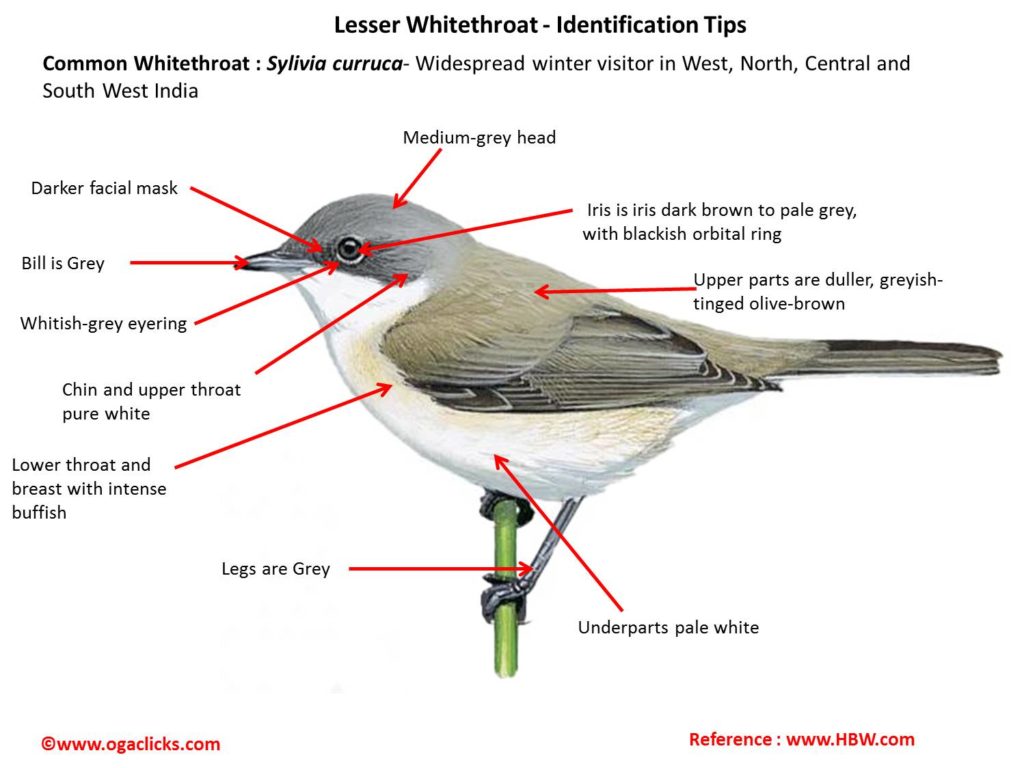Lesser Whitethroat

Lesser Whitethroat Sylvia curruca
Etymology:
- Sylvia : Latin word for “woodland sprite, little bird, warbler “
- Curruca : Swedish name krukafor Lesser whitethroat
Vernacular names: Sind: Chia, Kash: Chet hyot, Pun: Chittkanthipiddi, Guj: Bharatinanoshvetakantha, Nano swethkanth, Te: Chinnanallakampajitta, Mar: ChotaSubhrakanthiVatvatya
Distribution in India: Widespread winter visitor in India.
Description: Size of 12·5–14 cm; Wt. of 9·5–18 g. It is a small and slim Sylvia with greyish-brown appearance, narrow and moderately long tail, rather short bill. The nominate race has medium-grey head, darker facial mask, sometimes a vague white stripe over eye; rear nape and upperparts are contrastingly duller, greyish-tinged olive-brown. The tail is darkish with white edges and narrow tips on outer feathers, outermost rectrix has greyish wedge on edge of inner web and along shaft tip. The chin and throat are prominently white; underparts are whitish, with light grey to pinkish-brown suffusion on sides, more intense buffish on breast side and vent, leaving obvious central white patch. The iris is dark brown to pale grey, with blackish orbital ring; whitish-grey eyering; bill and legs are greyish.Boththe sexes are similar. The juvenile is more buffish-brown, less grey, than adult, with facial mask indistinct, white on edges of outermost rectrices more diffuse and less pure, underparts are more uniformly tinged buffish, iris is uniformly dark grey.
Habitat: It is found in open country or near forests in wide range of habitats rich in dense cover and lower-level foliage, such as shrubland, hedgerows and plantations with small trees;gardens, parks, cemeteries, orchards, young conifer plantations and forest edges. It is found from sea-level up to 2650m.
Food habits: It eats lepidopteron larvae, beetles, bugs, ants, flies spiders, myriapods, and small snails and slugs. The nestling diet includes bugs, lepidopteron larvae, dipteran flies, caddis flies and homopteran bugs. It also as eats seeds, nectar and pollen.It forages in trees and bushes, searching leaves, twigs and bark for insects. It also beats wings in attempt to flush prey.
Breeding habits: They breed in Apr to Aug in C Europe. They lay one brood per season. They are monogamous; solitary and territorial breeder. The male builds one or more “cock nests”, a simple platform intended to attract female; may be used later for construction of breeding nest, which built by both sexes. The nest is a deep cup of grass with rootlets and small twigs, also moss and spider webs and cocoons, usually lined with hair, placed in thorny bush or shrub, or in small tree, . They lay a clutch of 3–7 eggs. Theincubationis done by both sexes. The incubationperiodis11–12 days. The chicks arefed by both parents. The nestling period is 12–13 days. Thefledglings are fed for 18–20 days after leaving nest.